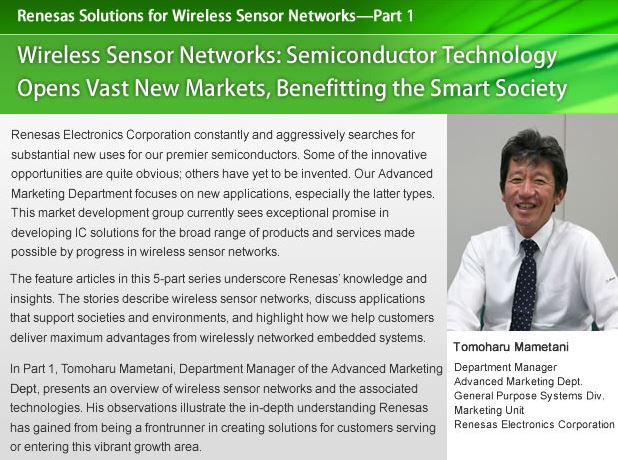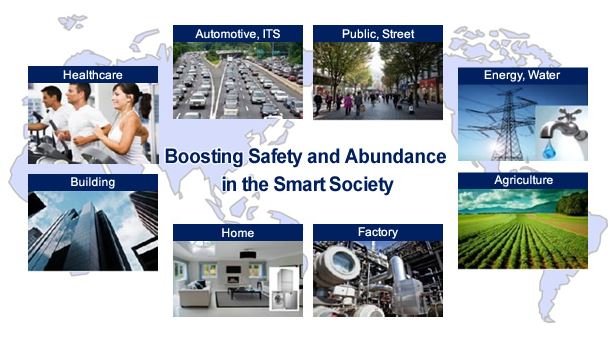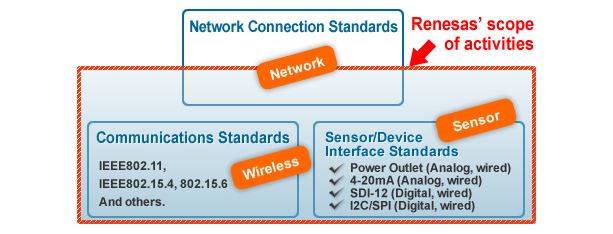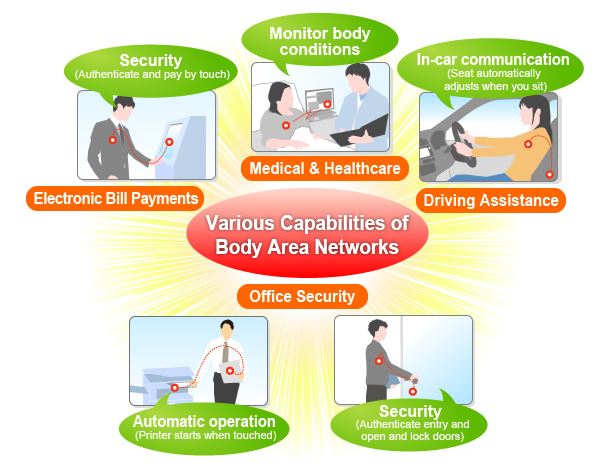
Utilizing Renesas’ expertise to help create and promote new markets
Because Renesas Electronics Corp. has massive technical capabilities and global coverage, we lead the semiconductor industry in supplying solutions for key embedded system applications worldwide. Within our corporation, the Advanced Marketing Department handles new business development. It takes charge of helping to create and build markets for semiconductor-intensive electronics applications likely to experience fast growth and high sales rates.
The experts in this department boost electronic manufacturers’ business successes by determining how semiconductor technology can meet current and projected end-user needs. Subsequently, they analyze design requirements for target applications and propose solutions that Renesas can produce. Thereafter, they promote market opportunities that apply our new and existing solutions, while offering guidance to our R&D, production and application engineering operations.
The activities of the Advanced Marketing Department allow Renesas to deliver, in a timely manner, next-generation chips and support products that enable system-engineering customers to design and manufacture superior end products. Being strategically positioned within the Marketing Unit, this group keeps Renesas at the forefront of product and technology trends across a vast number of embedded system applications.
Staying abreast of an incredibly rapid pace of change
The biggest challenge that this department faces is the amazing speed with which the electronics technology evolves—much faster than other segments of the economy. New electronic products are introduced and associated markets are born seemingly every day. Their movements from startup to growth phases can be quite spectacular.
New electronic devices, systems and applications often make major impacts on society, sparking more innovations and launching more startups. The electronics race is a non-stop sprint, and our customers are constantly seeking ways to gain head starts and sales advantages.
Figure 1 shows growth curves and typical solutions for various market segments today. Because the mission of the Advanced Marketing Department is to create and build new markets for applications that are in their startup phase (Area ‘A’ in Figure 1), this group of technologists is currently promoting Bio-Economy (BE), Energy Harvesting (EH), Visible-Light Communication (VLC) and Body Area Networks (BAN). Significantly, each of these technologies may lead to major advancements in wireless sensor networks.

Figure 1: Market life-cycle status for various markets and electronic products. Renesas’ Advanced Marketing Department focuses on facilitating growth in promising applications that are in the startup phase (Section A). The department’s experts are now driving advances in wireless sensor networks, especially those enabled by BE, EH, VLC and BAN technologies.
Laying the foundation for the Smart Society, chip by chip
The realization of the electronics-based physical and social environment called the “Smart Society” is the product of two factors: (1) advances in semiconductor technology that continually make more computing power available at lower cost, and (2) the surge in value provided as microcomputer capabilities have jumped from calculating, to control, to databases, to online activities, to anytime/anywhere connectivity and, finally, to artificial intelligence.
Being a leading global supplier of microcomputers and other chips, Renesas has long been a major force in the added-value trend. We offer and continue to develop leading-edge solutions for electronic products and systems that provide immeasurable benefits to Earth’s inhabitants and, indeed, to the planet itself.
Eliminating the need for wires and the limits they impose
Digital networks are ubiquitous today. They can be either wired or wireless, but most of them are wired. Wired implementations, though, are impractical in applications involving mobility. During the past decade or so, semiconductor technology has revolutionized wireless networks, making them incredibly practical and cost-effective. Indeed, wireless systems quickly have become the new norm and are making huge impacts on our daily lives.
Wireless sensor networks already play primary roles in numerous applications—weather observation being a prime example. It is now routine for up-to-the-minute data to be sent from remote observation points such as instrument shelters, weather ships, autonomous sea buoys, satellites, radar and Japan’s AMeDAS (Automated Meteorological Data Acquisition System). These data are transmitted via radio waves to a cloud-based collection center for rapid analysis. This wireless connectivity improves weather forecasts and stimulates new applications for environmental data.
The main engineering challenge for expanding the application horizon for wireless sensor networks is to find ways to decrease node size and cost. Especially, a big opportunity exists for economical, low-power wireless sensor modules small enough for easy placement in appropriate locations. Compact modules containing sensors, control electronics and data transceivers are ideal for remotely monitoring environmental and physical conditions for convenience, security, ecological and other purposes. Systems built with them will improve life and abundance in the Smart Society (see Figure 2).

Figure 2: Ways in which wireless sensor networks will impact the Smart Society. Innovative wireless networks with automatic monitoring and control capabilities can boost efficiency, decrease uncertainty, reduce risks, and increase comfort and convenience. Additionally, wireless deployments can tailor their system operations to changes in conditions and user demand, help ensure uninterrupted utility services, and perform many other valuable functions.
Using standardization to make wireless sensor networks more flexible
The previously described electronics module containing one or more sensors and a miniaturized transceiver is a main component of a wireless sensor network. Groups of modules, optimized for particular applications and situated wherever needed, communicate via radio or optical links with a remotely located system-management authority.
Operations within wireless sensor networks utilize three core technologies:
- Information technology (IT)—for acquiring, managing and analyzing sensor data
- Sensing technology—for automatically generating physical data (temperature, pressure, humidity, electrical conductivity, etc.) from different points within the network’s operational area
- Communications technology—for automatically routing and re-routing the data transmitted and received by network’s sensor nodes
These core technologies can be either proprietary (closed) or standards-based (open) functional environments. To obtain maximum versatility, though, the network connections, communication links and sensor and device interfaces should be standardized. That’s because the standardization of open environments enables interchangeability within the system, facilitating configuration modifications.
Various standards exist for implementing wireless and wired links (see Figure 3). However, to take full advantage of the monitoring and control opportunities being opened by the latest semiconductor technology, new standards are required. Specifically, three sets of standards are necessary to enable globally consistent wireless sensor networks: network standards, wireless standards, and sensor standards.

Figure 3: Standardization in key technology areas. Existing standards for network connections, wireless communications, and sensor and device interfaces can’t maximize the application potential of current and future semiconductor technology. So international standards organizations are working to develop a unified set of specifications and requirements applicable in all countries and regions.
Open system environments promote innovation, application adoption and market expansion. Thus our Advanced Marketing Department contributes to many standardization efforts. Although the group covers network standards, it now concentrates on supporting and promoting the international programs developing standards for wireless communication formats and interface standards for sensors and associated devices.
Seeking to accommodate the diversity of spectrum assignments
Accepted standards with approved specifications and conformance requirements define open environments. With regard to wireless sensor networks, Renesas strongly favors the adoption of optimized communication techniques to simplify and accelerate the development and deployment of sensor nodes and base stations. Sensor modules designed with proprietary electronic designs complicate efforts to attach modules from different suppliers, causing costly delays in development projects.
A very significant obstacle to wireless communication standardization efforts is the fact that radio spectrum assignments vary by country and region, defined by government regulations. The resulting inconsistencies raise system compliance costs and inhibit the globalization of wireless transceiver development. Finding ways to develop a uniform approach that accommodates diverse regulations poses an enormous engineering challenge.
At present, all countries permit wireless communication over the crowded 2.4-GHz frequency band. That explains why most wireless communication standards—including Wi-Fi®, ZigBee®, and Bluetooth®—are using it. In practice, however, this band tends to suffer from limited range. Now a worldwide effort is underway to develop a global wireless communication standard based on the use of sub-GHz bands. Renesas is contributing to the development of this standard.
Proposing new communication technologies: BAN and VLC
Besides providing chips that support communication over the crowded 2.4-GHz band, Renesas propels two new communication technologies that will expand markets for wireless networks: Body Area Networks (BAN) and Visible Light Communication (VLC).
Body area networks provide communications between electronic devices placed within a very limited area—specifically, the space immediately around a person’s body. Sensor modules in these wireless networks must be located on, inside, or very close to the body. Because communication is restricted to a small area, signal transmissions are highly secure.
We anticipate many applications for BAN, particularly in the healthcare, automotive, commerce and security markets (see Figure 4). Other applications are certain to emerge as suitable implementation components are introduced.

Figure 4: Anticipated applications for Body Area Networks. Wireless sensors in BAN communicate over very small areas, consume little power and offer excellent security. These networks allow interactions with electronic devices and systems to be automatically and precisely tailored to an individual’s physical characteristics, personal preferences and application requirements.
Visible light communication techniques transmit data on beams of light. They enable the design of wireless networks without radio transceivers. VLC network designs offer great promise for deployments where radio communication is restricted, like underwater operations, hospitals and airplanes. A major advantage of this type of data communication is that it is responsive to the interaction (blockage, refraction, etc.) of light with objects in the immediate vicinity. Therefore, VLC it is ideal for use within well-defined spaces, such as on streets, inside buildings, and in cars and trucks (see Figure 5).

Figure 5: Anticipated applications for Visible Light Communication technology. LED bulbs can provide more than just illumination; they can be momentarily switched off and back on again to imperceptibly and reliably transmit network data wirelessly. This VLC capability has many potential applications, such as the ones shown here.
Renesas’ Advanced Marketing Department foresees VLC technologies becoming a particularly attractive network communication technique, due to the growing use of LED lighting. Unlike incandescent and florescent light sources, LED lamps can be turned off and on again extremely quickly. So besides providing illumination, they can serve as digital encoders for serial data transmission.
Simply by controlling the on/off cycles of the LED lamps already installed in offices, for example, the bulbs can implement wireless network connectivity without causing any perceptible change in the illumination they provide. Moreover, LEDs are known to be reliable transmission sources, as demonstrated by their wide use as light sources for fiber-optic communication links. This gives LED-based VLC wireless communication installations an important system design advantage.
Expanding the operational capability of sensor modules
Decades of experience have shown that the multiple-path connectivity of wireless networks is very robust. These systems automatically map out their own communication routes. If a route failure occurs, they quickly remap network operation and continue to transmit and receive. For this reason, it’s important to realize that wireless sensor modules can be used for more than just generating sense data; they can also function as reliable network nodes. To do so, though, network-related information has to be inserted into each data packet. This raises both the module’s overhead and its energy consumption.
It might be possible to satisfy a sensor module’s power requirements completely or partially through the use of energy harvesting. Perhaps the module could be designed to capture available energy that is typically ignored, and then store and use it to perform its sensing and networking functions.
Many potential energy sources are suitable, since semiconductor sensor modules typically are low-power devices. Besides solar and wind sources, for example, the sensor’s electronics could make use of the energy expended when a person opens or closes a door or operates mechanical switches. Other approaches might include tapping the energy produced by people’s footsteps; obtaining power from waste heat produced by equipment, offices and factories; and generating energy from the vibrations of production machinery.
If energy-harvesting technology can be used to power wireless sensor modules, this will greatly simplify the process of deploying wireless networks. Energy-harvesting will also reduce costs by eliminating the need to install and replace batteries.
Easing transitions from wired to wireless sensor networks
Many wired sensor networks are already in place, and most of the existing sensor interfaces were designed for wired connections. Nevertheless, the Advanced Marketing Department expects wireless sensor networks to quickly grab market share from wired implementations.
That reality and the department’s vision of the future combine to give Renesas an important opportunity to help customers efficiently utilize their existing sensor resources as they transition system designs to wireless connectivity. We are assisting them to repurpose valuable legacy components, while also recommending our newest standard products.
Providing tools that can optimize sensor performance
Innovations abound in sensor technology. A recent examination of the latest developments in this area revealed that large numbers of human-mimicking sensors are appearing in various markets.
This trend has prompted Renesas to introduce “Smart Analog solutions” as support tools for adjusting sensor sensitivity, fine-tuning it during the production process to achieve precision device performance. Importantly, customers can also apply these same tools in the field, using them to dynamically correct the outputs of sensors whose characteristics change due to extended use or other factors.
Renesas is actively developing prototype system solutions that illustrate working wireless sensor network designs for selected applications. Presently we are engaged in several exciting proof-of-concept deployments in cooperation with partners from industry and academia. Also, we are developing more support tools for wireless sensor networks.
Previewing the remainder of this series
The four remaining installments of this series of EDGE articles take a closer look at the ways Renesas addresses the system-design needs of customers in rapidly expanding global markets for wireless sensor networks. The Part 2 story discusses body area networks; the Part 3 story describes energy harvesting; and the Part 4 installment covers commercial applications. Finally, the Part 5 article provides a more detailed look at visible light communication technology.
EDGE greatly appreciates the information that Tomoharu Mametani has provided for this article. The Part-2 Body Area Network story will be published in February. Please watch for it.
If you do not see the information you need here, please contact us via the link below.
Contact us
Wi-Fi is a registered trademark of the Wi-Fi Alliance.
ZigBee is a registered trademark of ZigBee Alliance, Inc.
Bluetooth is a registered trademark of Bluetooth SIG, Inc.
Advertisement
Learn more about Renesas Electronics America





